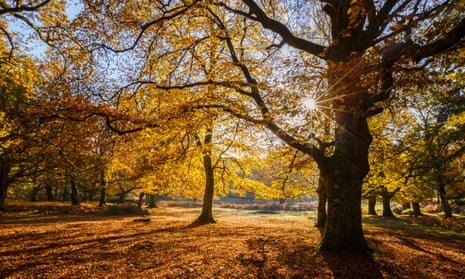There is an evil empire haunting this collection of woodland pieces: the Forestry Commission. During the 20th century the wicked commission planted conifers the length and breadth of Britain, often felling ancient woodlands in the process. Bright, airy broadleaf forest rich in animal and plant life was replaced (with official blessing) by dreary ranks of Corsican pine or Norwegian spruce – strangers to our shores – that soon choked out all the flowers beneath them. The trilling of thousands of birds was replaced by the soughing of regimented evergreens. Open hillsides were obliterated by endless swaths of deepest green that seemed to suck in the very sunlight. Peat bogs were sacrificed. Fast–growing timber became a crop as mundane as sugar beet.
Adrian Cooper is director of Common Ground, an organisation dedicated to local distinctiveness, so to him these commercial and soulless forests are anathema. His collection of essays is a celebration of most of the woody things that the Forestry Commission forests lack: individuality, personal connections and affections, quirkiness, even scruffiness.
If there was a superhero to bring down the evil empire it was surely Oliver Rackham, whose death in 2015 deprived us of the greatest scholar of woodland history we have ever had. Many essays in this book acknowledge the influence of Rackham, who meticulously established the antiquity and employment of old woodland through much of Britain, but especially East Anglia. He changed minds. By 1980 the value of ancient woodland was widely appreciated, both from a cultural and an ecological point of view. “Tree huggers” were once viewed slightly askance as arboreal hippies, but now we all love trees – that is, nice, native broadleaved trees and not badly behaved foreigners.
The irony is that these same species have never been more threatened: by sudden oak death, ash die-back, alder blight, and other problems still obscure, following on from the Dutch elm disease that had already transformed the landscapes beloved of John Constable. The Forestry Commission have belatedly become more sympathetic stewards of trees, while the government’s attempt to sell off the national forests was stymied by general outrage, and rejected by parliament in 2011. Like other naturalists who could scrape together the resources, I bought my own piece of woodland shortly afterwards, just in case.
Cooper has assembled a distinguished bunch (or should that be “grove”?) of writers to share their favourite woodlands with us: Richard Mabey, Ali Smith, William Boyd, Germaine Greer, Philip Hoare, Jay Griffiths, Alan Garner and Simon Armitage among them. Writerly quirks and contrasting styles parallel the spread of localities and their diverse characters in a way that becomes almost overwhelming in its profuseness. I am obliged to pick a few pieces that particularly appeal.
Hoare’s tales of the eccentrics who hung out in the New Forest are irresistible. The visionary Mary Ann Girling and her band of the Children of God – including women who became whirling dervishes and lost all their clothes – must have shaken up the local rustics in the 1870s. A decade or so later, the son of the Earl of Carnarvon, Auberon Herbert, built a rambling mansion – Old House – secreted deep in the forest, to which he continually added rooms in an apparently random fashion, and filled them all with spectacular collections of bric-a-brac, dominated by odd-shaped flints to which he attached unfathomable significance. Between the wars, the forest became a centre for Gypsies “living wild”, who were corralled into camps, known as compounds, at the behest (of course) of the Forestry Commission.
I enjoyed Peter Marren’s account of one particular tree, a fine elm in the middle of the Wiltshire town of Ramsbury, but then I knew that tree as a child. And I, too, found my way to the King Oak in Savernake Forest not far away. It always seems to be venerable oaks that acquire personal names: queens and kings and princes. Their longevity binds us to history.
Less consciously literary essays tell us more about the real problems of managing forests. Robin Walter, a practical controller of woodland, takes us through Kingsettle Wood in Dorset as “a living structure in four dimensions”, explaining how he selects which tree to fell, which tree to leave, for the better health of the whole. Simon Leatherdale’s tale of the restoration of Chalkney Wood in Essex is an inspiring example of bringing a famous ancient wood back from the brink of oblivion. And I was touched by Zaffar Kunial’s attachment to his urban laburnum in Birmingham – which is about as far from the wildwood as could be. There is kind of democracy in trees: we are all entitled to our very own.
I did not expect Greer’s essay to be the most pedagogical, but it is. She outlines what makes a tree different from a herb, taking us through the structure and function of xylem and phloem. It might be a class for Botany 101; useful, but hardly heartfelt. At the other emotional extreme Tobias Jones explains what he terms “Nature Deficit Syndrome”, and how he uses trees as therapy for young addicts.
Paul Kingsnorth writes about another of my childhood wonders, Burnham Beeches, a miraculously preserved ancient beechwood near the City, owned by the Corporation of London since medieval times. He opts for a view of the forest as a superorganism mediated by a kind of fungal intelligence connected through tree roots by a mycorrhizal “internet”. The forest may be watching you, he says. Mycorrhiza is real enough, of course. I am reminded of the hyperbole that followed James Lovelock’s Gaia theory, which was a rationally argued case for Earth systems science. Once co-opted by a metaphysical mafia it became altogether touchy-feely: it lost rigour as it gained emotional leverage. The view of woodland as intelligent is equivalent to tree hugging on a global scale. Woodland is special enough without this dubious imprimatur.

Comments (…)
Sign in or create your Guardian account to join the discussion